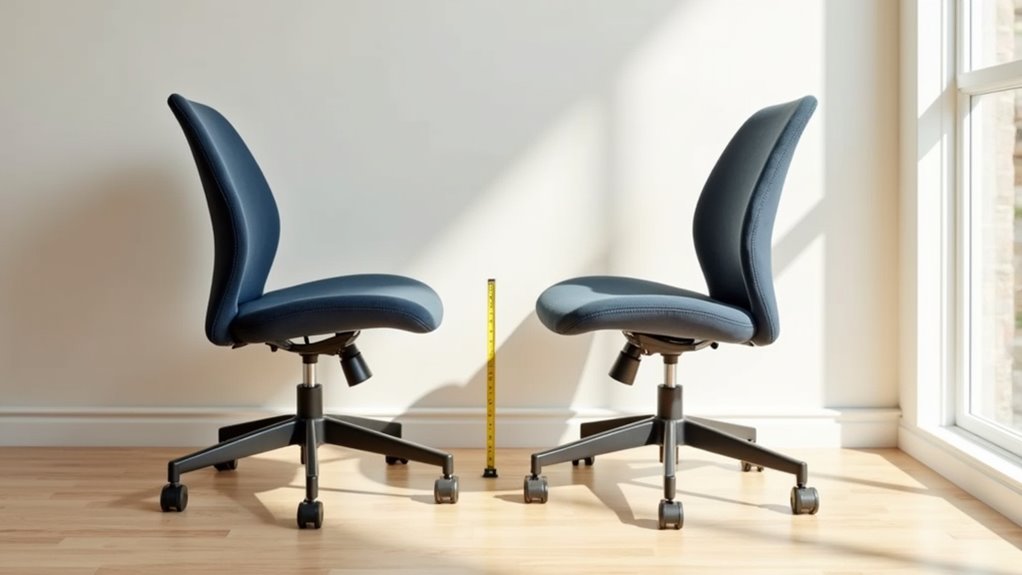How to Properly Sit in an Office Chair
This post contains affiliate links. As an Amazon Associate, we earn from qualifying purchases.
To sit properly in an office chair, adjust the seat height so your knees form a 90-degree angle with your feet flat on the floor. Ensure there’s a 2 to 4-inch gap between the seat and the back of your knees, and that lumbar support aligns with your lower back’s curve. Keep your elbows at a comfortable 90 degrees as well. For those interested in more detailed tips and explanations, further insights will be provided later in the article.
Essential Facts in 30 Seconds
- Adjust seat height to just below kneecap to promote good posture.
- Maintain a 2 to 4-inch gap between seat edge and back of knees for optimal seat depth.
- Position lumbar support to fit the curve of your lower back for comfort.
- Set armrests so elbows bend at 90 degrees, keeping forearms parallel to the floor.
- Keep feet flat on the floor or footrest, with knees bent at about 90 degrees for alignment.
Adjusting Seat Height for Optimal Posture
Adjust the seat height of your office chair for better comfort and posture. Start by measuring from the floor to the bottom of your kneecap while seated. Keep your feet flat on the ground. This helps create a 90-degree angle at your knees. Make sure to check your measurement again. Ask a friend to help if you can.
Aim for a seat height just below your kneecap. This position helps maintain good posture. For people between 5’7″ and 5’10”, a height between 17″ and 19″ works best. Taller individuals may need a higher seat. Ergonomic chair height is crucial for comfort and can significantly impact your productivity throughout the day. Adjusting your chair to prevent slouching is important for maintaining a healthy spine alignment. Proper setup enhances your overall sitting experience and can reduce discomfort over time. Additionally, ensuring your chair height aligns with proper height adjustment techniques can further improve your sitting posture.
Shorter people should aim for a height between 14″ and 16″. Keep your legs comfortable and feet flat on the ground. This way, blood flows easily. Adjust your chair until it feels just right. Your back will appreciate it!
Finding the Right Seat Depth for Comfort

Finding the right seat depth greatly improves your comfort at the desk. A good fit makes a big difference! Here’s how to find the best seat depth for you:
- Measure from your buttocks to the back of your knees.
- Keep a gap of about 2 to 4 inches between the seat edge and your knees.
- Your knees should be at a 90-degree angle or slightly more while sitting.
- Adjust your chair to support your back. Keep your feet flat on the floor.
- Use adjustable seat depth features to get your perfect fit. Proper posture is essential for preventing discomfort and enhancing overall sitting experience. Additionally, ensuring that your chair supports lower back can contribute significantly to overall comfort. A well-adjusted seat depth can also promote better circulation and reduce fatigue during long periods of sitting. Moreover, adjustable height is crucial in maximizing ergonomic benefits and ensuring proper alignment.
Comfort leads to better focus and productivity.
Make these adjustments to feel great while you work!
Ensuring Proper Lumbar Support
After finding the right seat depth, it’s time to support your back! Proper lumbar support keeps your spine healthy. Adjust the lumbar support to fit the natural curve of your lower back. Place a hand behind your back to find the right spot. It should feel snug, not too tight. Maintaining correct sitting posture is essential for overall spinal health. Regularly assessing your chair selection can further enhance your comfort and support.
Incorporating lumbar rolls or cushions can provide additional support if your chair lacks adequate back support. Check your chair’s materials. Firm yet soft support is ideal. Think of it as a gentle hug for your back. Proper lumbar support reduces lower back pain and enhances your overall comfort while sitting.
If your chair lets you adjust the height and depth, that’s even better! This way, it will fit your back perfectly, no matter how much you move.
Positioning Arms and Elbows Correctly

Here are some easy steps to follow:
- Adjust your armrest height. Your elbows should bend at about 90 degrees. Keep your forearms parallel to the floor.
- Change the armrest width. Your elbows need to be right under your shoulders. This prevents stretching.
- Keep your shoulders relaxed. Your upper arms should stay close to your body.
- Armrests should support you. They shouldn’t make you shrug your shoulders or lean. Proper armrest positioning can alleviate neck and shoulder tension. Additionally, ensuring that your shoulders are relaxed is essential for maintaining a comfortable posture.
- Check your armrests often. Adjust them to stay comfortable and avoid tired muscles.
Additionally, ensuring that the proper height of your chair is maintained can significantly enhance overall comfort while working.
With these tips, you can create a better workspace and feel great while you work!
Maintaining Feet Placement and Leg Alignment
Proper foot placement and leg alignment are very important for your comfort and focus at work. Keep your feet flat on the floor or use a footrest. Avoid dangling or crossing your legs. This helps improve blood flow and reduces strain. Additionally, proper chair height adjustment can significantly enhance your sitting experience and overall posture.
Adjust your chair height so your knees bend at about 90 degrees. Your thighs should be parallel to the floor. If your feet don’t touch the ground, a footrest is a great solution. It will support your heels and help you sit better. Proper sitting posture leads to better comfort and productivity. Additionally, maintaining proper sitting position can prevent long-term injuries caused by poor ergonomics.
Frequently Asked Questions
How Often Should I Adjust My Chair Throughout the Day?
Adjust your chair every 30 to 60 minutes. This keeps you comfortable. Good chair adjustments help you sit properly. Proper posture prevents pain. It also boosts your focus. Your workspace should help you work better. Small changes make a big difference. Remember, comfort is key for a productive day. Stay aware of how your body feels. Don’t wait until you’re uncomfortable to adjust. Simple adjustments can improve your well-being.
What Are the Signs of an Improperly Adjusted Chair?
Many people suffer from back pain due to poor chair adjustments. Studies show that 80% of individuals face this issue. Check your chair for these signs of improper adjustment:
- Seat height too low or high
- Lumbar support missing or inadequate
- Armrests misaligned or too high
These problems can cause long-term health issues. Adjust your chair to improve comfort and support. A well-fitted chair can make a big difference. Prioritize your health by ensuring your chair is set up correctly.
Can a Chair Affect My Productivity Levels?
A chair can significantly impact your productivity. A comfortable chair helps you focus better. Ergonomic features support your body and reduce pain. Less discomfort means fewer distractions. You can work more efficiently and effectively. Studies show that good seating can improve work output. Investing in a quality chair pays off in productivity. Choose a chair that fits your needs for the best results. Comfort is key to staying on task and getting things done.
Is It Beneficial to Take Breaks While Sitting?
Taking breaks while sitting is very helpful. Breaks can reduce muscle strain and help you feel better overall. They also boost your focus and alertness.
Research shows that short pauses during the day can improve your health. Standing up and moving around helps your body stay active. This can make your workday more productive.
Even a few minutes of stretching or walking can make a big difference. Try to take breaks every hour. This simple habit can lead to better well-being and work performance.
How Do I Choose the Right Office Chair for My Needs?
Choosing the right office chair is important for your comfort. Focus on ergonomic features. Look for lumbar support. This helps your lower back. An adjustable height is also key. It lets you find the best position for your desk.
Consider the materials of the chair. Breathable mesh keeps you cool. High-density foam offers good support. Both options can make long hours at a desk more comfortable.
Think about your daily use. A good chair can help you work better. Comfort leads to focus and productivity. Take your time to find the right fit. Your body will thank you!
Conclusion
Sitting properly in your office chair is key for comfort and health. Good posture helps you avoid back pain and keeps you focused. Adjust your chair height so your feet rest flat on the floor. Your knees should be at a right angle. Support your lower back with the chair’s lumbar support. Keep your shoulders relaxed and arms close to your body. Use a desk that allows your elbows to stay at a 90-degree angle.
Take breaks regularly. Stand up, stretch, and move around. This keeps blood flowing and reduces fatigue. A good chair can make long work hours much easier. A comfy seat helps you stay productive and happy at work. Follow these tips to make the most of your office chair. You’ll feel better and work better, too!
